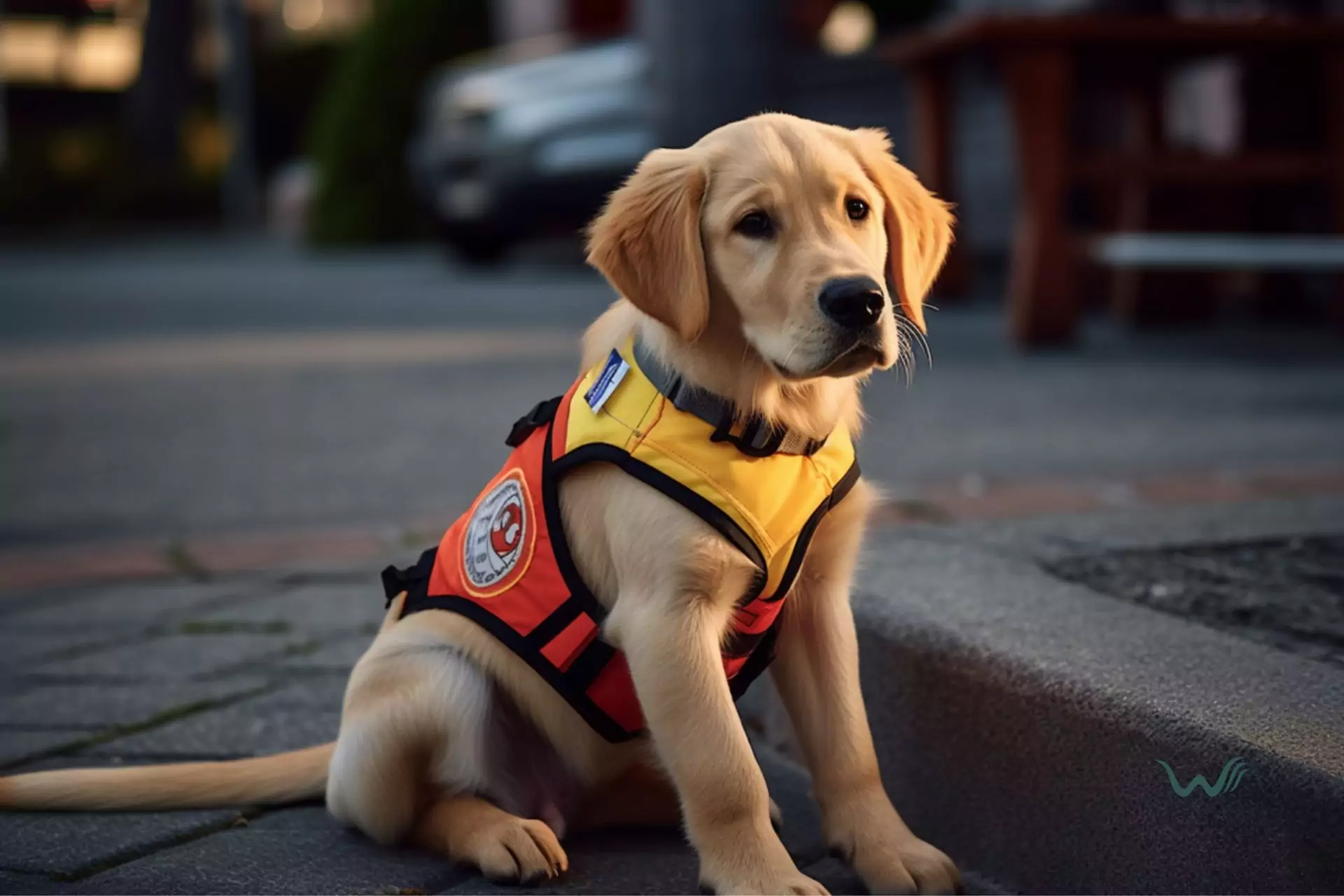

What’s The Difference Between ESA And Service Dogs
by Haley Mills
Last updated: April 20, 2024
Verified and Approved by:
Angela Morris,
MSW, LCSW
Fact Checked

If you’ve heard of emotional support animals (ESAs) and service dogs, you may wonder what the difference is between the two. While both types of dogs provide assistance and support to their owners, there are distinct differences in their legal protections, training requirements, and tasks they perform.
ESAs are dogs (or other animals) that provide emotional support to their owners, typically those with mental health conditions or disabilities. Unlike service dogs, they are not trained to perform specific tasks but rather provide comfort and companionship. On the other hand, service dogs are highly trained to perform specific tasks to assist their owners with disabilities such as blindness, deafness, mobility impairments, and medical conditions like seizures.
Defining ESA and Service Dogs
Let’s talk about the difference between ESA and service dogs, shall we? ESA stands for Emotional Support Animal, while service dogs are specially trained to perform specific tasks for individuals with disabilities.
Emotional Support Animals provide comfort and support to owners suffering from emotional or mental disabilities. These animals are not trained for specific tasks but provide emotional support through their presence and companionship. Mental health professionals often prescribe them and can include many animals, such as dogs, cats, birds, and even miniature horses. ESA’s are protected under the Fair Housing Act and the Air Carrier Access Act, which allows individuals with emotional or mental disabilities to have their ESA’s with them in their homes and on flights.
On the other hand, service dogs are specifically trained to perform tasks that assist individuals with physical, sensory, psychiatric, intellectual, or other disabilities. These tasks can include guiding the visually impaired, alerting the hearing impaired, reminding individuals with psychiatric or cognitive disabilities to take medication, or even providing physical support to those with mobility impairments. Service dogs are highly trained and are legally recognized as medical equipment, allowing them to accompany their owners in all public places, including restaurants, stores, and public transportation.
Legal Protections and Regulations
It’s important to understand the legal protections and regulations of having an emotional support animal or service dog, as they can greatly impact the lives of those who rely on these animals for assistance and companionship. Emotional support animals are protected under the Fair Housing Act and the Air Carrier Access Act, allowing them to live with their owners in housing and travel on airplanes without additional fees or restrictions. However, these animals do not have the same legal rights as service animals, as they are not trained to perform specific tasks to assist their owners with disabilities.
On the other hand, service dogs have more extensive legal protections and regulations. The Americans with Disabilities Act defines a service animal as a dog trained to perform specific tasks to assist a person with a disability. These tasks can include guiding individuals who are blind, alerting individuals who are deaf, and helping individuals with mobility impairments. Service dogs are allowed to accompany their owners in all public areas, including restaurants and stores, and are protected under federal law. Individuals with service dogs need to understand their rights and responsibilities under the law and the training and certification requirements for their dogs.
Training and Certification Requirements
To fully understand the training and certification requirements, you should research the guidelines for both ESA and service dogs. With regards to service dogs, they undergo extensive training to become certified. The training process typically involves a minimum of 120 hours, covering areas such as obedience, task training, and public access training. After completing the training, the dog must pass a certification test to become a fully certified service dog.
On the other hand, ESA dogs do not have specific training or certification requirements. While it is recommended that they receive basic obedience training, there are no specific guidelines or regulations for their training. However, landlords and airlines can request documentation from a licensed mental health professional to verify the need for an ESA. It is important to note that misrepresenting an ESA as a service dog is illegal and can have serious consequences.
Tasks and Roles of Each Type of Dog
Each type of dog has unique tasks and roles that serve its owners differently. Service dogs are trained to perform specific tasks that assist their owners with disabilities. These tasks can include guiding individuals with visual impairments, retrieving items, alerting them to sounds, and providing support during balance and mobility. Service dogs also receive extensive training to remain calm and focused in public places, making them essential companions for their owners.
On the other hand, emotional support animals (ESAs) do not have specific tasks or training requirements. Their primary role is to provide comfort and emotional support to individuals with mental health conditions or disabilities. They do not have public access rights, and their presence is only allowed in homes and airplanes. ESAs can be any breed of animal, including dogs, cats, birds, or even rabbits. They do not have to be trained to perform specific tasks, but their presence alone can provide emotional support to their owners.
Can I Use a Service Dog as an Emotional Support Animal in a Rental Property?
Navigating pet policies after relocation, tenants should clarify “esa in rental postmove” allowances. Landlords must accommodate service dogs, but emotional support animals, though not pets, require prior approval. A service dog, recognized for aid beyond emotional comfort, typically gains acceptance in rental properties, ensuring residents’ well-being.
Eligibility and Requirements for Obtaining Each Type of Dog
If you’re considering obtaining either dog, you should know the specific eligibility and requirements for both ESA and service dogs. For an ESA, the process is relatively simple. You must have a qualifying mental or emotional disability and receive a licensed mental health professional recommendation. There are no breed or training requirements for ESAs, although they should be well-behaved in public. Additionally, ESAs are not granted public access rights like service dogs but are allowed in housing and on airplanes with proper documentation.
Service dogs, on the other hand, have much stricter requirements. They must be trained to perform tasks that mitigate their handler’s disability. The handler must have a qualifying disability under the ADA, and the dog must be trained to perform tasks specific to that disability. Service dogs have no breed restrictions, but they must be well-behaved in public and undergo extensive training. Service dogs are granted public access rights, allowing them to go anywhere their handler goes, including restaurants, stores, and other public places. Obtaining a service dog can be a lengthy and expensive process, but it can be life-changing for those who require one.
Conclusion
In conclusion, while ESA and service dogs offer support and assistance to their owners, there are significant differences. ESA dogs provide emotional support and are not required to undergo specialized training or certification. Service dogs, on the other hand, perform specific tasks to assist individuals with disabilities and must undergo rigorous training and certification processes to ensure they are prepared for their roles.
Individuals need to understand the distinctions between ESA and service dogs to ensure they receive the appropriate legal accommodations and protections. Whether you need emotional support or require assistance with daily tasks, resources are available to help you determine which type of dog is best suited for your needs.
Can any breed of dog be an ESA or service dog?
Any breed of dog can technically be trained as an ESA or service dog if they can perform the necessary tasks and meet the required temperament and behavior standards.
How do you know if you need an ESA or a service dog?
To determine whether you need an ESA or Service Dog, consult a licensed healthcare provider. They can assess your specific needs and recommend the appropriate type of assistance animal.
Can an ESA or service dog be trained to perform multiple tasks?
Both ESA and service dogs can be trained to perform multiple tasks. However, service dogs are trained to perform specific tasks to assist individuals with disabilities, while ESAs provide emotional support without specific training.
How do you find a reputable organization to train or certify your ESA or service dog?
To find a reputable organization to train or certify your ESA or service dog, research online and ask for recommendations from your veterinarian or other dog owners with trained dogs. Look for accredited organizations with positive reviews, like Wellness Wag.
Certify Your Emotional Support Animal Today

Why You Can Rely on Us?
At Wellness Wag, we believe your pet deserves care rooted in both science and compassion. Each article is carefully researched, written in clear language for pet owners, and then reviewed by qualified professionals to ensure the information is evidence-based, current, and practical for real-life care. Our goal is to help you feel confident in making informed decisions about your pet’s health and well-being.
Reviewed by
Angela Morris, MSW, LCSW
Angela is a licensed clinical social worker with 20 years of experience in patient advocacy and community mental health. She has assisted numerous clients with ESA evaluations and brings a deep understanding of disability accommodations, ensuring that all information is accurate, supportive, and practical.

Written by :
Haley Mills
Last Updated :
April 20, 2024












